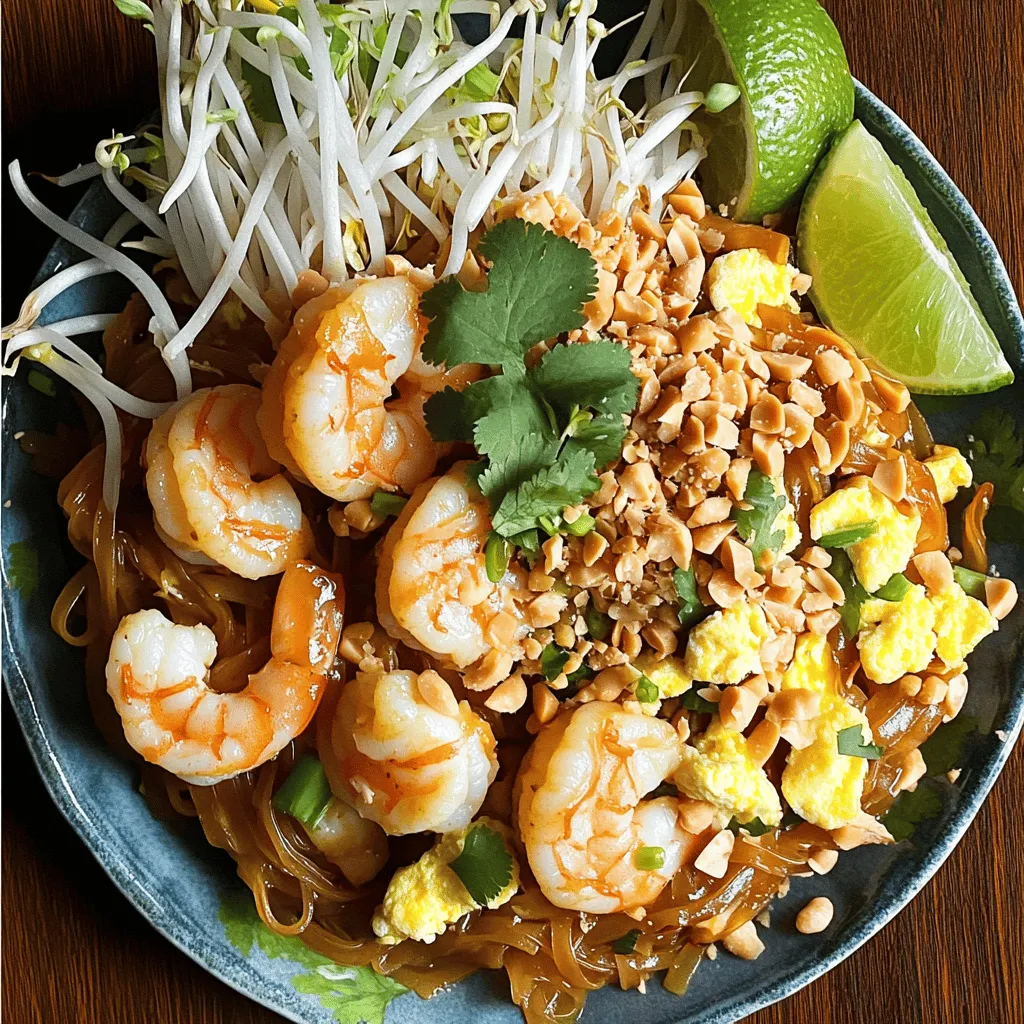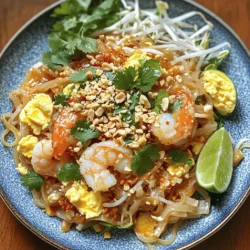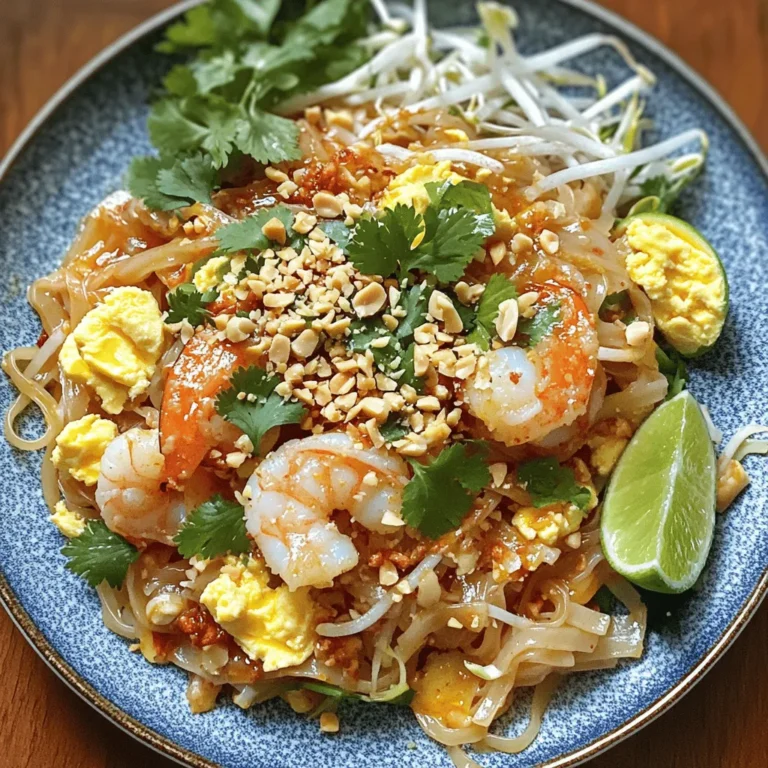Craving a tasty meal in minutes? You’re in the right place! In this guide, I’ll show you how to whip up Easy Pad Thai that bursts with flavor. No need to be a pro cook; just follow my step-by-step instructions. Whether you prefer chicken, shrimp, or tofu, you’ll find all the tips for customizing this dish. Let’s explore the quick journey to a delightful plate of Pad Thai!
Ingredients
Detailed Ingredient List
– Flat rice noodles: I use 8 oz of flat rice noodles. They are the star of this dish. You can also use other types if you like. Just make sure they cook well.
– Protein options: For protein, I love adding 1 cup of shrimp. You can swap it with tofu or chicken. Tofu is great for a vegetarian delight!
– Essential seasonings and condiments: Fish sauce is key here. I use 3 tablespoons for depth. Tamari sauce is a good swap if you’re vegan. I also add 2 tablespoons of tamarind paste for a tangy kick. Brown sugar adds a hint of sweetness.
– Fresh vegetables and garnishes: I toss in 1 cup of bean sprouts for crunch. Green onions add flavor and color. Use 1/2 cup, chopped into small pieces. Finally, I sprinkle 1/4 cup of crushed peanuts on top. Fresh cilantro and lime wedges are lovely garnishes.
This simple list makes a tasty Pad Thai that you can whip up in no time.
Step-by-Step Instructions
Preparation Steps
1. Cooking the rice noodles: Start by boiling water in a large pot. Add 8 oz of flat rice noodles. Cook them for about 7-8 minutes, or until they are soft. Drain the noodles and let them cool.
2. Heating the oil and sautéing garlic: In a large pan or wok, add 2 tablespoons of vegetable oil. Heat it over medium-high heat until it shimmers. Add 2 cloves of finely minced garlic. Sauté for about 30 seconds until it smells great, but do not let it burn.
3. Cooking protein and scrambling eggs: Next, add 1 cup of shrimp, peeled and deveined. Sauté for 2-3 minutes until the shrimp turns opaque. Push the shrimp to the side. In the empty space, pour in 2 large eggs that are lightly beaten. Scramble the eggs until they are just set, then mix them with the shrimp.
Combining and Finishing
1. Incorporating the noodles, sauces, and sugars: Add the drained rice noodles to the pan. Pour in 3 tablespoons of fish sauce and 2 tablespoons of tamarind paste. Sprinkle in 1 tablespoon of brown sugar. Toss everything together to coat the noodles well.
2. Adding fresh veggies and final adjustments: Stir in 1 cup of rinsed bean sprouts and 1/2 cup of chopped green onions. Cook for another 2-3 minutes. This helps everything to blend well and heat through.
3. Serving suggestions and presentation tips: Once done, remove the pan from heat. Serve the hot Pad Thai in shallow bowls. Sprinkle with 1/4 cup of crushed peanuts and garnish with fresh cilantro. Add lime wedges on the side for a zesty finish. Enjoy your delicious masterpiece!
Tips & Tricks
Cooking Tips for Beginners
1. Common mistakes to avoid
A common mistake is overcooking the noodles. They should remain slightly firm. If they are too soft, your dish may turn mushy. Also, don’t skip the garlic! It adds great flavor.
2. How to adjust flavors to personal preference
Taste your Pad Thai while cooking. If you want it sweeter, add more brown sugar. For saltiness, add extra fish sauce or soy sauce. If you enjoy spice, add chili flakes or sriracha.
3. Best tools for cooking Pad Thai at home
Use a large pan or wok for even cooking. A spatula helps you stir well and mix all ingredients. A pot for boiling noodles is key. You may also want a sharp knife for chopping veggies.
Ingredient Substitutions
1. Vegetarian and vegan alternatives
For a vegetarian dish, swap shrimp with tofu. You can use soy sauce instead of fish sauce. This keeps the flavor rich without meat.
2. Gluten-free options for noodles and sauces
Look for rice noodles labeled gluten-free. You can also find gluten-free soy sauce. This makes your dish safe for those with gluten issues.
3. Suggestions for quick ingredient swaps
If you don’t have tamarind paste, use lime juice mixed with brown sugar. You can replace bean sprouts with shredded carrots for crunch. If you lack peanuts, sunflower seeds work well for garnish.Enjoy creating this tasty meal!

Variations
Protein Variations
You can switch up the protein in Pad Thai to suit your taste.
– Pad Thai with chicken or beef: If you prefer meat, chicken or beef works great. Just slice them thinly and cook until tender.
– Shrimp vs. tofu for a vegetarian option: Shrimp adds a nice flavor. If you want a vegetarian meal, use tofu instead. It soaks up the sauce well.
– Seafood Pad Thai alternatives: You can also use a mix of seafood. Think scallops or squid for a unique twist.
Flavor Variations
Changing the flavors can make Pad Thai exciting.
– Spicy Pad Thai options: Add chili flakes or hot sauce for heat. Adjust to your spice level!
– Low-sugar or healthier adaptations: Use less sugar or swap it with a sugar substitute. It keeps the taste but cuts the calories.
– Add-ins for extra nutrition: Toss in veggies like bell peppers or carrots. They add crunch and extra vitamins.
Feel free to mix and match these ideas. You can find your perfect Pad Thai style!
Storage Info
Storing Leftovers
To keep your Pad Thai fresh, place it in an airtight container. This helps prevent sogginess. Pad Thai is best kept in the fridge. It will stay good for about three days. You can also freeze it for longer storage. If you freeze it, use a freezer-safe bag or container. Make sure to remove as much air as possible. This helps keep the food fresh and tasty for up to three months.
Reheating Tips
When it’s time to reheat, avoid the microwave if you can. A pan or wok is best. Heat it on low to medium heat. Add a splash of water or oil to help steam the noodles. Stir gently to avoid breaking them. This keeps the noodles soft and chewy.
To maintain the flavor, consider adding a bit more fish sauce or lime juice. Adjusting the seasoning can bring back the original taste. Remember to watch the heat. High heat can dry out the noodles. Enjoy your delicious Pad Thai just like it was fresh!
FAQs
How to make Pad Thai vegetarian?
To make Pad Thai vegetarian, swap out meat for tofu. Tofu provides protein and absorbs flavors well. You can also use tempeh or seitan for a meat-like texture. For sauce, replace fish sauce with soy sauce or tamari. Add extra veggies like bell peppers or carrots for more crunch and color. This way, you keep it tasty and filling.
What can I use if I don’t have tamarind paste?
If you lack tamarind paste, use a mix of lime juice and brown sugar. This mix gives a similar tangy flavor. Another option is to use vinegar with sugar, which can also work well. You can even use Worcestershire sauce, but it will change the taste slightly. Each of these swaps will help you keep the flavor profile close.
Can I make Pad Thai in advance?
Yes, you can make Pad Thai in advance! Prepare the noodles and sauce, but keep them separate until serving. Store them in airtight containers in the fridge. When ready to eat, simply reheat the noodles and mix with the sauce. This way, you save time on busy nights.
What is the best way to serve Pad Thai?
Serve Pad Thai in shallow bowls for a nice look. You can garnish with crushed peanuts, fresh cilantro, and lime wedges. These toppings add flavor and color. Pair it with a simple green salad or spring rolls for a complete meal. This adds variety and makes the dish more fun.
How long does Pad Thai last in the fridge?
Pad Thai lasts about 3-4 days in the fridge. Keep it in an airtight container to stay fresh. Look for signs of spoilage, like off smells or changes in color. If it seems off, it’s best to toss it. Always trust your senses to keep your meals safe.
You now have all the tools to make a great Pad Thai. We covered the key ingredients like flat rice noodles, proteins, and seasonings. You learned simple steps to cook and combine everything well. I shared tips to avoid mistakes, adjust flavors, and substitute ingredients.
Pad Thai is flexible and fun, allowing you to explore different proteins and flavors. Enjoy experimenting in the kitchen. With practice, you’ll master this dish and impress friends and family. Don’t forget to store and reheat leftovers properly for the best taste. Happy cooking!


